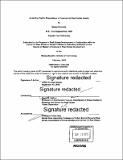Analyzing capital expenditure in commercial real estate assets
Author(s)
Chavada, Mehul (Mehul Meghji)
DownloadFull printable version (5.084Mb)
Other Contributors
Massachusetts Institute of Technology. Center for Real Estate. Program in Real Estate Development.
Advisor
.
Terms of use
Metadata
Show full item recordAbstract
The ability of Commercial Real Estate to provide strong current income returns has long been one of its benefits of inclusion into a long-term portfolio. Capital Expenditures can significantly hamper this income return of commercial properties and mislead the investors into making misguided decisions. However, there has long been an informational vacuum about capital expenditure and the current available literature can best be described as non-existent. This thesis focuses entirely on capital expenditure to understand the future implications of Capital Expenditure Spending, and to understand the co-relation between different property characteristics and capital expenditure. The thesis uses contingency tables to understand the behavior of commercial properties over a span of nine years. The goal was to understand if capital expenditure spends have an impact on future spends. If an investor invests high (low) capital expenditure in the present do they keep spending high (low) all throughout their hold periods or their spending changes over time. Secondly, regression analyses is used to better understand the relationship between different property characteristics and capital expenditures and this exercise helps build an intuition about capital expenditure spends. The contingency tables and regression analyses revealed distinguishing trends about capital expenditure and helped understand its behavior. It was revealed that investors currently spending high on capital expenditures are not necessarily successful in saving capital expenditure spends in the future. The regression analyses defined a positive correlation for capital expenditure with respect to age, sq. ft, NOI and market value and it defined a negative co-relation with respect to cap rate and location considering the property was located in the top six markets in the country.
Description
Thesis: S.M. in Real Estate Development, Massachusetts Institute of Technology, Program in Real Estate Development in conjunction with the Center for Real Estate, 2016. Cataloged from PDF version of thesis. Includes bibliographical references (pages 33-34).
Date issued
2016Department
Massachusetts Institute of Technology. Center for Real Estate. Program in Real Estate Development.; Massachusetts Institute of Technology. Center for Real EstatePublisher
Massachusetts Institute of Technology
Keywords
Center for Real Estate. Program in Real Estate Development.